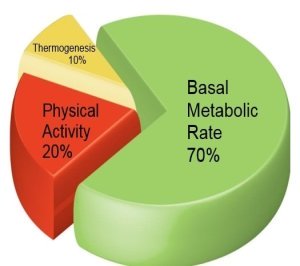BMR Calculator

Use this BMR calculator to determine your basal metabolic resting rate. There are several variables that are used in the BMR calculation.
These include age, gender, weight and height. These factors are used to determine your resting BMR.This calculator will tell you the number of calories per day you should consume to maintain your existing weight based on the resting BMR.
You can use either the metric or US measurements for this online tool.
BMR Calculator
Use this free calculator to determine your Basal Metabolic Rate. If you are looking to lose weight, you need to understand your daily calorie needs first.
Activity Level Guide
Sedentary = Little or no exercise
Somewhat Active = Light exercise 1 - 3 days a week
Moderately Active = Moderate exercise or sports 3 - 5 days a week
Very Active = Hard exercise or sports 6 - 7 days a week
Extremely Active = Hard daily exercise or sports plus physical job or exercise two times a day
How to use the BMR Calculator
Just select your gender and then plug in your weight and height information. Be sure to select the correct measurement for each (pounds or kg for weight and inches or cm for height).
You will be presented with the calories per day based on the input information. To determine what your daily calorie intake should be in order to start losing weight, you will need to know and understand your basal metabolic rate.
BMR is the amount of calories you would burn while at rest like sleeping. Even while at rest, your body burns calories. It uses these calories for functions like breathing, blood circulation and maintaining body temperature just name a few.
Your BMR is responsible for burning sixty to seventy percent of the total calories you will burn in a day. Understanding this is the first step in creating a calorie defict for losing weight.
Results of the BMR Calculator
So why two results? Well the BMR result is your resting rate. Basically this means the amount of calories you burn while inactive, like sleeping.
Even though you are not active, your body is. In order to breath, digest, pump blood and maintain body temperature, you need energy. This energy is the calories that are burned during these bodily functions.
The second result is the amount of calories you need in order to maintain your current weight based on your activity level. The more active you are the more calories you will require.
This is because you are already burning the calories you need in order to sustain life. So if you add activity to this, you need to increase the amount of calories you consume to maintain your weight.
If you are trying to lose weight, then you need to reduce your calories. You can do this by consuming (eating) fewer calories or increasing your activity to burn more calories...or a combination of both.
If you reduce the calories you eat, or increase the calories you burn by 500 each day, this would approximate to 1 pound loss for the week. At 1000 calorie reduction, this would be 2 pounds per week of weight loss.
Experts recommend that you try to lose 1 - 2 pounds a week and no more. Studies have shown that a quicker weight loss often leads to additional weight gain once the diet is done.
So in order to keep the weight off, you want to lose it slowly. This will help you develop lasting lifestyle changes that will help ensure the weight stays off.
Basal Metabolic Rate Definition

Basal Metabolic Rate, or BMR, is your metabolic rate while at total rest, like sleeping. It is measured in calorie expenditure, which is calories burned.
Your BMR is responsible for approximately 60 to 70% of the total number of calories you burn in a day. That's a lot of calories burned without doing any exercises.
This calorie expenditure is used for basic body functions. These functions include digesting, breathing, pumping blood and maintaining body temperature. Basically, your Basal Metabolic Rate is the amount of calories used to sustain life.
Importance of Basal Metabolic Rate
Why is understanding your metabolic rate and understanding the definition important for weight loss? In order to lose weight, you must create a calorie deficit. Meaning you must consume fewer calories than you burn.
To better understand the calories you need for weight loss, you need to start with the calories you burn from your metabolic rate. Remember the BMR is responsible for approximately 60 - 70% of the calories you would burn in a day.
So starting here will help you determine how many calories to consume from the foods you eat. It will also help you determine how many calories you want to burn through your workouts.
Consuming fewer calories and burning more calories can create a calorie deficit, which in turn will lead to weight loss. Creating a calorie deficit can be done one of several ways.
- Consume fewer calories
- Burn more calories
- Do both
By doing both, consuming fewer calories consumed and burning more calories, you can easily create that calorie deficit for weight loss.
What Can Impact BMR?
In addition to age, gender, weight and height playing a role in your BMR, other things can impact this as well. For instance, if you are ill, your BMR can change during the illness.

Additionally, hormones can impact your basal metabolic rate. The thyroid gland produces Thyroxin, which is an important hormone to help your BMR. If a person does not produce enough Thyroxin, their metabolic rate will slow down.
Certain medications may also impact your metabolism. Be sure to check with your doctor to see if any medicines you are taking impact your metabolism.
Genetics can play a role in your BMR. Some people will have a naturally higher metabolism while others will be slower. Although this may not seem fair it is what we are dealt and have to work with what was given to us.
Lastly, dieting can impact your basal metabolic rate. If done properly, you can actually increase your metabolism by eating healthy and adding exercise, both aerobic exercises and strength training.
But if you diet incorrectly, you will actually slow down your metabolism.
Don't Crash Diet

Many people make the mistake of going on a “crash” diet in hopes of a quick weight loss. The problem is that if a person reduces their calorie intake by too much, the body reacts by going into survival mode, slowing down your metabolism and lowering your BMR.
What happens when you lose weight fast is that you are also likely losing muscle. This then lowers your lean body mass and in turn lowers your BMR.
A general rule is to never go below 1200 calories/day for women or 1800 calories/day for men, which are extremely low calorie levels.
What Can You Do To Raise BMR?
One thing you are in control of, and can have a positive effect on your metabolic rate, is your activity level.
By adding exercise to your weekly routine, you are not only burning additional calories, which will help create that calorie deficit for weight loss, but you are increasing lean body mass. And since muscles burn more calories than fat, you are increasing your basal metabolic rate.
Be sure to read these other benefits to exercise.
BMR Calculation
If you are curious about the math behind this BMR calculator then be sure to read on. The basal metabolic rate calculation takes into account many different variables. There are different methods used for the calculation with the most common being the Harris-Benedict formula.
This formula uses height, weight, age and gender to determine your basal metabolic rate. The results of the Basal Metabolic Rate calculation using these variables are an estimate, but will be fairly accurate for most people.
No one formula will be exact as there are other factors, such as family traits and frame size that are not taken into account. Therefore all of the various calculators will be an approximation of your BMR.
BMR Calculation Explained

There are several variables that are used in the BMR calculation. These include age, gender, weight and height. These factors are used to determine your resting BMR. Additionally the activity level is used to determine your total daily caloric needs. You may be wondering why and how these variables are used in the BMR calculator.
Well, age plays a role in your metabolic rate. As we age, our metabolism slows down. I know this doesn't seem fair to those of us over 40, but it's true. Gender also plays a role in the calculation. Why? Well men tend to have more lean muscle and the more lean muscle you have the higher your basal metabolic rate.
Lastly, body surface is needed to determine your BMR calculation. This is why both weight and height are used. The more body surface you have, the more calories you burn through your basal metabolic rate. However, because lean body mass is not a variable in the Harris Benedict formula, it may be inaccurate for those that are extremely muscular as it may underestimate caloric needs. This is because muscles are more metabolically demanding than fat.
It may also be inaccurate for people with an extremely high percentage of body fat, overestimating their caloric needs as your body uses fewer calories to sustain the fat.
Harris-Benedict Formula
As stated above, this BMR calculator is using the Harris-Benedict formula to determine the results. Note that this formula uses kilograms for weight and centimeters for height. Below this formula you will see the conversion factors to use for pounds and inches.
Women: 655 + (9.6 x weight) + (1.8 x height) - (4.7 x age in years)
Metric to Imperial conversion
1 inch = 2.54cm
Example If you are 5’3” (or 63”), then you height in cm equals 63 inches x 2.54 cm = 160 cm
1 pound = .45 kg (1 kg = 2.2 pounds so 1 pound divided by 2.2 kg equals .45)
Example If you weight 160 pounds, then your weight in kg equals 160 lbs x .45 kg = 72 kg
So, if you are a 40 year old female weighing 150 pounds at 5’3” (or 63 inches), your calculation would be;
655 + (9.6 x [150 lbs x .45 kg]) + (1.8 x [63 inches x 2.54 cm]) – (4.7 x 40)
655 + (9.6 x 68 kg) + (1.8 x 160 cm) – (188)
655 + 653 + 288 – 188 = 1408 calories/day
The Activity Factor
A weight loss calculator will use the results of your basal metabolic rate calculation and then factor in an activity level. This will give you the amount of calories you burn based on the BMR as well as your exercises.
The reason you need to understand the activity factor for this BMR calculator, is you want to ensure you are consuming enough calories for your BMR as well as your level of exercise. By factoring in the activity level in a weight loss calculator you will get the proper daily calorie intake needs to sustain and/or lose weight.
Below is what is used to factor in the activity level.
Exercise/Activity multiplier
Activity Level |
Factor |
Description |
| Sedentary | BMR x 1.2 | no or little exercise |
| Lightly active | BMR x 1.375 | light exercise 1 - 3 days/week |
| Moderately active | BMR x 1.55 | mod. exercise/sports 3 - 5 days/week |
| Very active | BMR x 1.725 | hard exercise/sports 6 - 7 days/week |
| Extremely active | BMR x 1.9 | hard daily exercise/sports plus physical job or exercise 2x a day |
Example:
If your basal metabolic rate is 1408, then based on your activity level, your daily calorie needs to maintain your weight would be as follows;
- Sedentary = 1408 x 1.2 = 1690
- Lightly active = 1408 x 1.375 = 1936
- Moderately active = 1408 x 1.55 = 2182
- Very active = 1408 x 1.725 = 2429
- Extremely active = 1408 x 1.9 = 2675
Additional Calculators
Here are more free online calculators on this site. In addition to these online tools, check out the weight loss tools page for some offline spreadsheets you can download to help you lose weight.
Weight Loss Calculator
This online calculator helps you determine how many calories you need each day in order to lose weight. With a nifty little slider, you can
even find out about how long it will take to reach your goals.
BMI Calculator
The Body Mass Index calculator will help you determine if you have a potential health risk due to your current weight.
Exercise Calorie Calculator
Find out how many calories you burned during your workout with this free online tool.
Weight Watchers SmartPoints Calculator
Are you a member? Then use these calculators to find the value in the foods you eat.
Additional Articles
Weight Loss Tips
If you want to lose weight but are not sure where to start, then check out this article. These tips will help you understand what changes you
need to make in your life to get fit and healthy.
Exercise Tips
With any weight loss plan, adding exercise can help you reach your goals sooner. So use these tips to get started with your workout routines.
Body Mass Index Calculation
Your BMI, or Body Mass Index, is a tool used to determine if you are at a health risk due to your current weight. Find out how it's calculated
and see if you are at risk.
